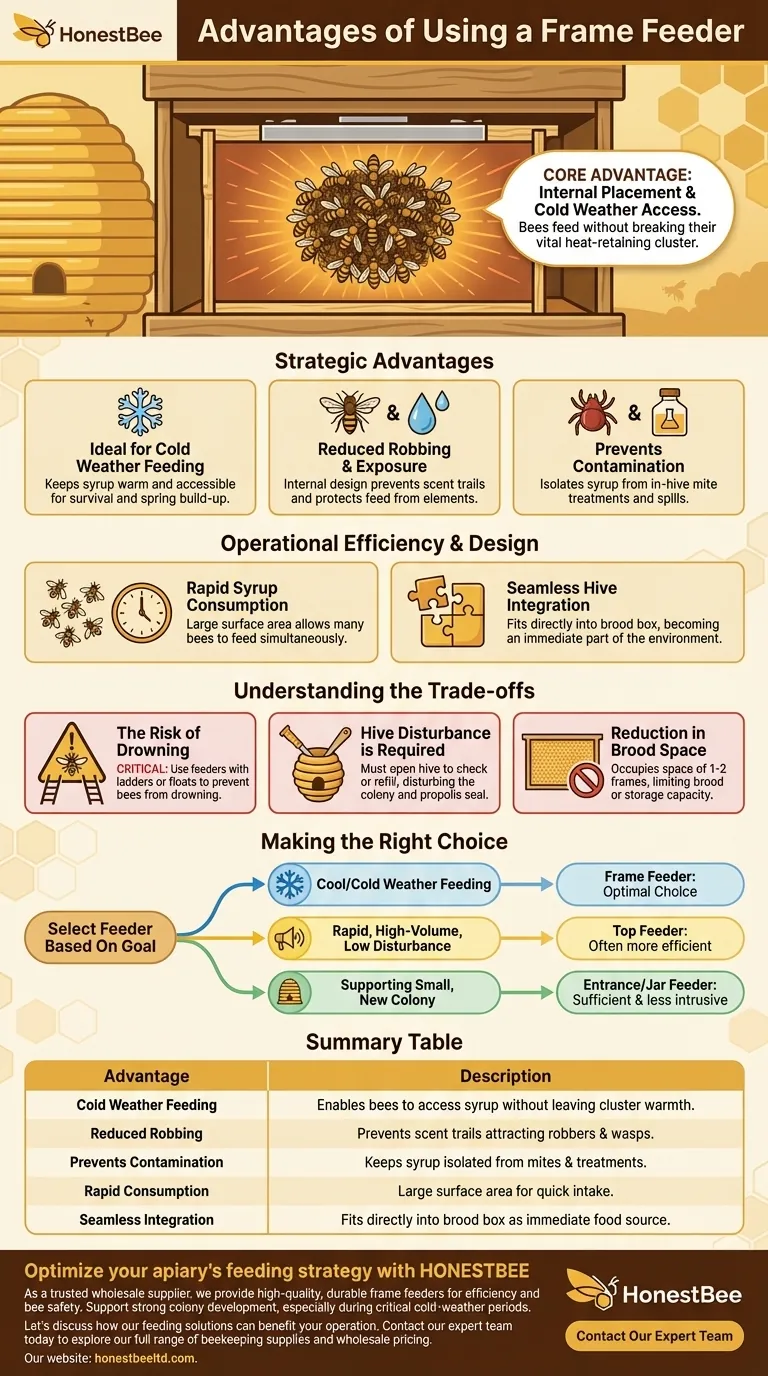At its core, a frame feeder is an in-hive feeding system prized for its efficiency and safety, especially in specific conditions. Its primary advantages stem from its placement directly inside the hive body, which protects the feed from the elements, reduces the risk of robbing from other insects, and keeps the food source close to the bees during cold weather.
The most significant advantage of a frame feeder is its internal placement. This makes it the superior choice for feeding bees during the cooler temperatures of early spring and late fall, as it allows the colony to access food without breaking their vital heat-retaining cluster.

The Strategic Advantage of In-Hive Placement
A feeder's location is just as important as the feed it contains. Placing the feeder inside the hive, in place of a standard frame, provides several distinct benefits that external feeders cannot match.
Ideal for Cold Weather Feeding
In cooler weather, bees form a tight cluster to maintain the critical temperature of the brood nest. A frame feeder allows them to access syrup without having to leave this warmth, which is essential for survival and spring build-up.
Reduced Robbing and Exposure
Because the syrup is entirely contained within the hive, it does not create an external scent trail that can attract robber bees from other colonies or wasps. This internal design also protects the feed from rain, which can dilute or spoil syrup in external feeders.
Prevents Contamination
A well-designed frame feeder keeps the sugar syrup isolated. This prevents the feed from spilling onto the bees or coming into contact with any in-hive mite treatments, ensuring the colony receives clean, uncontaminated nourishment.
Operational Efficiency and Design
Beyond its location, the design of a frame feeder is built for specific management goals, primarily the rapid and direct delivery of syrup.
Rapid Syrup Consumption
Most frame feeders have a large surface area, often with integrated ladders or floats. This allows a large number of bees to feed simultaneously, enabling the colony to consume a significant quantity of syrup quickly when needed.
Seamless Hive Integration
The feeder fits directly into the brood box or super, replacing one or two frames. This makes it a structurally simple addition that integrates directly into the bees' living space, making the food source an obvious and immediate part of their environment.
Understanding the Trade-offs
No piece of equipment is perfect for every situation. To use a frame feeder effectively, you must understand its limitations.
The Risk of Drowning
The most significant drawback is the potential for bees to drown in the syrup. It is absolutely critical to use a feeder that includes built-in ladders, floats, or other flotation material that allows bees to access the syrup safely and climb out.
Hive Disturbance is Required
To check the syrup level or refill the feeder, you must open the hive. This disturbs the colony and breaks the propolis seal they have worked to create, which is less ideal than using an external top or entrance feeder that can be managed with minimal intrusion.
Reduction in Brood Space
A frame feeder occupies the space of one or two frames. For a strong, expanding colony, this is a direct trade-off against space that could be used for laying eggs or storing honey and pollen.
Making the Right Choice for Your Goal
Selecting a feeder is a strategic decision based on the season, colony size, and your management objectives.
- If your primary focus is feeding during cool or cold weather: The frame feeder is the optimal choice because it keeps syrup warm and directly accessible to the bee cluster.
- If your primary focus is rapid, high-volume feeding with minimal disturbance: A top feeder is likely more efficient, as it often holds more syrup and can be refilled without opening the brood chamber.
- If your primary focus is supporting a small, new colony: A simple entrance or mason jar feeder may be sufficient and less intrusive than sacrificing valuable brood space for a large frame feeder.
Ultimately, choosing the right feeder requires matching the equipment's strengths to the specific needs of your colony at that moment in time.
Summary Table:
| Advantage | Description |
|---|---|
| Cold Weather Feeding | Enables bees to access syrup without leaving the warmth of the cluster. |
| Reduced Robbing | Internal placement prevents scent trails that attract robber bees and wasps. |
| Prevents Contamination | Keeps syrup isolated from mites and hive treatments. |
| Rapid Consumption | Large surface area allows many bees to feed simultaneously for quick intake. |
| Seamless Integration | Fits directly into the brood box, making food an immediate part of the environment. |
Optimize your apiary's feeding strategy with HONESTBEE.
As a trusted wholesale supplier for commercial apiaries and beekeeping equipment distributors, we provide high-quality, durable frame feeders designed for efficiency and bee safety. Our equipment helps you support strong colony development, especially during critical cold-weather periods.
Let's discuss how our feeding solutions can benefit your operation. Contact our expert team today to explore our full range of beekeeping supplies and wholesale pricing.
Visual Guide

Related Products
- Professional In-Hive Frame Bee Feeder by HONESTBEE
- 3.5L Plastic Beehive Frame Feeder Deep Frame Water Feeder for In Hive Use
- Professional Hive Front Entrance Bee Feeder
- Rapid Bee Feeder White Plastic 2L Round Top Feeder for 8 or 10-Frame Bee Hives
- In-Hive Dual Compartment Frame Bee Feeder for Targeted Colony Nutrition
People Also Ask
- What are the two most popular types of honey bee feeders? A Guide to Frame and Bucket Feeders
- Are frame feeders good? Maximize Your Hive's Health with the Right Feeding Strategy
- What are the different types of honey bee feeders? Choose the Right Feeder for Your Hive
- What are the types of internal feeders used in beekeeping? Optimize Your Hive's Nutrition Strategy
- How do frame feeders prevent drowning of bees? Essential Safety Design for Healthy Hives



















